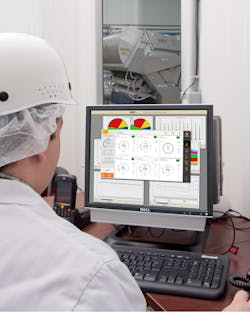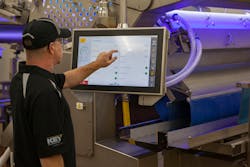The exact date is a bit hazy, but condition monitoring probably started soon after mankind’s first tool broke and had to be repaired.
The discipline has expanded by fits and starts ever since, with two of the main limiters being the skill level required to interpret condition indicators of complex machines and the labor cost of collecting condition data. Remote monitoring with wireless sensors and the ability to interpret condition data and generate maintenance work orders are changing the calculus of the payback and usefulness.
Extracting data about machine health is a necessary first step for any maintenance program that aims to anticipate mechanical breakdowns. For decades, manufacturers turned to skilled technicians to visit their facilities and collect condition data. It was slow, costly and not particularly effective.
But the combination of remote sensors, communications networks operating independently of the plant’s own network and the ability to turn raw data into actionable information promises to curtail unscheduled downtime and increase production.
Pandemic-related disruptions sparked heightened interest in remote machine monitoring and better predictive maintenance. Worldwide spending on predictive maintenance was $4 billion a year before Covid-19 disrupted plant operations. Manufacturers now are increasing those investments at a 26 percent annual clip, according to Research and Markets. By 2027, predictive maintenance spending will reach $18.6 billion.
By contrast, overall maintenance, repair and operations expenditures are increasing 2.7 percent a year.
Like virtually everything else, prices are ratcheting up for monitoring systems that use digital wireless sensors and gateways that collect and transmit encrypted data via the internet to a third-party hosted server — in marketing parlance, cloud-based analysis via the Industrial Internet of Things.
At Austin, Texas-based Swift Sensors, sensor prices are higher than they were a few years ago but still within the affordability range. Instrumentation requiring human-machine interface to collect the data costs magnitudes more, not including the labor cost.
Most wireless systems have adopted Bluetooth Low Energy 5 as their personal area network. That extends battery life to as much as eight years, “a three-fold increase over coin-cell batteries,” according to John Pasquarette, Swift’s chief marketing officer. Makers of the gateways that relay sensor data to a third-party hosted server or the plant’s Wi-Fi network or SCADA system typically rate them at 300 ft. for line-of-sight connection to sensors, though the practical range is closer to 100-150 ft.
Temperature and vibration sensing are typical for maintenance-related systems, but there are many nonprocess-related opportunities for remote monitoring. Ambient moisture measurement and contact (on/off) sensing are examples. Automatic detection when an exterior door is opened or a rodent trap is occupied might be useful information for plant security and sanitation workers.
Traditionally, manufacturers connected sensor data to enterprise systems such as SCADA, PLCs or plant Wi-Fi, but connecting to the cloud can be just as secure. It also short circuits turf wars with IT.
“The first job of IT is to say, ‘no,’” deadpans J. Wright, a founder of Somax Inc., in Alpharetta, Ga., a long-time provider of CMMS software at bakeries and dairies. Sensor networks that connect to enterprise systems require hefty expenditures to build the firewalls required by IT.
“Some of our industrial customers opt to bypass the (internal) network completely and will choose to go with our cellular modem option” as an IT-avoidance tactic, adds Pasquarette.
The global food companies working in recent years with Augury Inc., a provider of machine and production health solutions, insist on integration of sensor data with their enterprise data systems, says Artem Kroupenev, vice president of strategy. But when Augury began operations, it would send technicians to facilities to collect data from HVAC compressors and pumps with a device attached to a cell phone. Field technicians no longer are needed, but pairing sensors with cellular communications offers a faster and less painful route to remote monitoring, particularly at small to mid-sized companies.
Architects of the Axios service from SKF USA Inc., Lansdale, Pa., were cognizant of the non-maintenance related uses for wireless monitoring when they designed their wireless machine-health monitoring system.
“Our skill set is rotating assets,” says Sam Bainbridge, director-technology delivery. “We’re not an engineering firm, so a manufacturer who wanted to collect data on sanitation cycles or some other function would have to work with a systems integrator.”
However, SKF’s data network is sufficiently agnostic to accommodate non-maintenance functionality. “We have the ability to set up a data pipeline to other systems,” he says.
SKF selected Amazon Web Services for data security and machine learning analytics. SKF specialists are available for complex data analysis; Axios provides machine learning and automated alerts when deviations from predetermined operating parameters are exceeded. “We automate the identification of anomalies, but we don’t provide root cause of failure or what exactly must be done to correct the problem,” adds Bainbridge.
When the service was introduced, data was accessible only through a mobile app. Today, a web browser also can be used. Either way, end-to-end encryption is built in.
The Ability line of smart sensors from ABB Motion and Drives give manufacturers the option of transmitting data with a phone app. It is the core product in ABB’s condition monitoring line-up. Users can add ala carte services such as alarm management and asset health checks. Data from drives, motors, pumps and other rotating equipment can be transmitted to ABB’s cloud server, or manufacturers can send it to another organization’s cloud.
Multiple options exist in how that data get on the plant’s network. The simplest solution is to use cell-phone technology. Placing a SIM card in a gateway modem might add a recurring $40 monthly phone charge, allows Pasquarette, but it creates condition-monitoring systems that operate independently of the plant’s data-communication networks.
One alternative is to relay data via the plant’s Wi-Fi system. In that case, “IT is going to jump in,” notes Pasquarette. Security becomes an even bigger issue if sensor data streams to the manufacturer’s Ethernet.
Equipment reliability always is a consideration when evaluating hardware. Wireless vendors are addressing uncertainty by putting warranties front-and-center in their marketing pitches. SKF USA offers a five-year warranty on hardware. Swift Sensors’ warranties sensors for two years, and gateway hardware carries a lifetime warranty.
Augury shoulders the reliability concerns. That’s because Augury doesn’t sell hardware: It leases it to end-users. The firm provides Software as a Service, folding sensor fees into a subscription service that includes machine health analytics and alarms and alerts to plant maintenance personnel.
Semi-automatic intelligence
Collecting data is pointless unless it results in actionable information. Machine-heath data mining is beyond the core competencies of most manufacturers. Fortunately, there is no shortage of suppliers who stand ready to provide the analytics.
Increasingly, OEMs are on-boarding sensors on the machines they sell. Those sensors are part of the remote monitoring services they hope to extend to manufacturers. These service offerings are particularly prevalent among packaging machine makers.
Most of these vendor services claim to use artificial intelligence to crunch the data and deliver actionable alerts. At best, they could be characterized as AI Lite. To minimize the frequency of false alarms, human beings usually get involved when complex assessments are needed, as is the case with vibration analysis.
While none of the automated analytics software would pass a Turing Test, they could be considered passive AI. The more data they collect on comparable machines and equipment, the better they become at interpreting performance anomalies.
An example is the condition monitoring service launched by Tetra Pak five years ago. It draws data from more than 5,000 Tetra Pak packaging machines worldwide to benchmark performance and predict failure.
Here’s a prediction: Everything will break at some point. The time and date for failure are contingent on how soon a maintenance technician services the unit and what procedures are performed. Unless machine failure is imminent, a prediction algorithm might pinpoint what machine component is likely to fail, but pinpointing the time is a stretch.
Nevertheless, Augury’s Kroupenev predicts, “We can predict machine failure months and weeks in advance, essentially eliminating downtime and increasing production capacity without having to build another facility.” False alarms are minimal, thanks to an ever-expanding database of monitored machines. More than 100,000 rotating machines with more than 200 million cumulative hours of operation feed into that database, and he expects the machine population to double within two years.
Holistic monitoring
Flow rate and pressure monitoring in industrial spraying systems and contact sensors in refrigeration systems are among the candidates for wireless remote monitoring. Regardless of the application, “remote monitoring is where we see a lot of traction,” Swift’s Pasquarette says.
Machine monitoring may be leading the wireless revolution, but demand for other monitoring applications could lead to a cacophony of sensor-generated signals. OEMs are trying to pre-empt the problem by offering to support remote monitoring of machinery from other firms, as well as their own.
Key is expanding its maintenance service to overseeing the performance of equipment upstream and downstream of its sortation systems, regardless of OEM. This moves Key’s data collection and analysis services into the process control arena.
An even more ambitious expansion of remote monitoring is playing out at snack maker. In 2021, Augury began a three-month pilot project at four Midwestern plants of Augury’s real-time data collection and analysis service. Heat, vibration and magnetic field sensors are Augury’s primary tools of data collection. Those tools produced downtime reductions that added the equivalent of four months’ worth of added production time at those facilities. Product waste was reduced by 1 million lbs.
Seebo is even more food-centric in its work than Augury. Instead of monitoring machine health, Seebo focuses on process health. Last year, Augury acquired Seebo, expanding the former's capabilities to end-to-end monitoring.
Seebo cites Nestle, Mondelez, Barilla and PepsiCo in its client roster. Seebo’s point of contact with those facilities is process engineers, while Augury interacts with maintenance and reliability managers. But the hardware that underpins their machine and process health services is the same.
“There are always concerns around security,” Kroupenev allows, but clients trust Augury sufficiently to let it embed its software in the enterprise system. That facilitates automatic generation of work orders and, importantly, allows Augury to monitor the consequences of those repairs. “If we misdiagnose, we repair or replace the machine,” he says.
Machine health monitoring is making steady inroads, but energy consumption, environmental monitoring and a plethora of other applications are on manufacturers’ wish lists. By building wireless networks that are reliable, secure and agnostic, plant managers can prepare their facilities to realize additional efficiencies.





